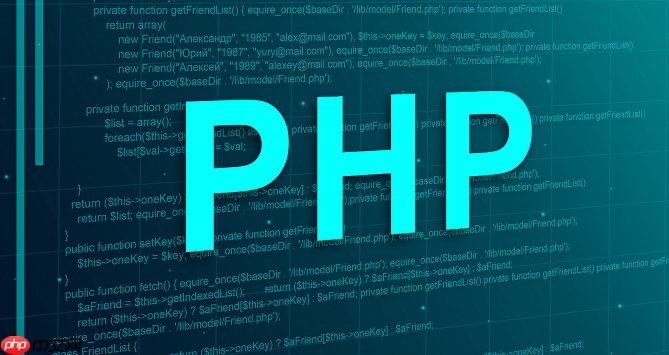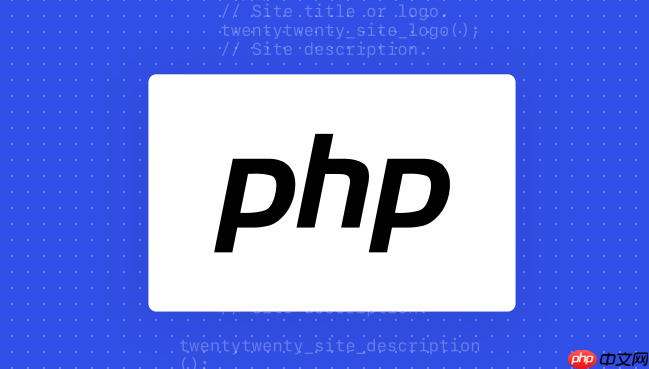 Backend Development
Backend Development
 PHP Tutorial
PHP Tutorial
 PHP development user permission management monetization PHP permission control and role management
PHP development user permission management monetization PHP permission control and role management
PHP development user permission management monetization PHP permission control and role management
Jul 25, 2025 pm 06:51 PMUser permission management is the core mechanism for realizing product monetization in PHP development. It separates users, roles and permissions through a role-based access control (RBAC) model to achieve flexible permission allocation and management. The specific steps include: 1. Design three tables of users, roles, and permissions, and two intermediate tables of user_roles and role_permissions; 2. Implement permission checking methods in the code such as $user->can('edit_post'); 3. Use cache to improve performance; 4. Use permission control to realize product function layering and differentiated services, thereby supporting membership system and pricing strategies; 5. Avoid the permission granularity is too coarse or too fine, and adopt the "resource operation" naming specification; 6. Permission verification must be performed on the backend to prevent security vulnerabilities hidden in the front end but not verified in the backend; 7. Implement data-driven permission management through backend configuration to reduce maintenance costs. The permission system is not only a technical module, but also a key tool for product monetization.

To put it bluntly, user rights management in PHP development determines who can do what and cannot do. This is not just a technical implementation level, it directly relates to how your product is layered, priced, and even how it will be monetized in the end. A properly designed permission system is the core cornerstone of building differentiated services, implementing paid functions, and even supporting the entire SaaS model.

Solution
To implement PHP user rights management, the most core idea is to adopt role-based access control (RBAC). This is much more flexible and maintainable than assigning a bunch of permissions directly to each user.
Imagine that we have three types of entities: Users, Roles, and Permissions. A user can be assigned one or more roles, and each role is associated with several specific permissions. When a user tries to perform an action, the system checks whether the role that the user has contains the permissions required to perform the action.

In terms of specific implementation, this usually involves several database tables:
- users table : store user information.
- roles table : Store role information, such as "administrator", "ordinary member", and "VIP user".
- permissions table : Store specific permission points, such as "Edit article", "View background data", and "Download advanced reports".
- user_roles intermediate table : Associate users and roles, because a user can have multiple roles.
- role_permissions intermediate table : Associate roles and permissions, because a role can have multiple permissions.
At the PHP code level, you need a permission checker. For example, you can write a can() method: $user->can('edit_post') . This method will query all roles owned by the current user, and then use these roles to find all permissions associated with them, and finally determine whether the edit_post permission exists in the user's permission set. For performance, these permission data are usually cached, avoiding complex database queries for each request.

How can user permission management become the core driving force for product monetization?
To be honest, many times when we talk about technology implementation, it is easy to ignore the commercial value behind it. But user permission management is not just a technical module, it directly determines how many tricks your product can be used to monetize.
You think, your product may have a basic version, which is provided to all registered users for free, which corresponds to a set of basic permissions. Then, you want to launch advanced features such as data analysis reports, exclusive customer service, and ad-free experience, which correspond to different "permission packages". You package these permission packages into different membership levels or subscription plans, such as "Professional", "Enterprise", and "VIP Exclusive Edition". In order to obtain these additional permissions, users have to pay for upgrades.
It's like a layered cake, each layer corresponds to different values and prices. The permission management system is the knife that cuts the cake, which allows you to accurately control the recipe and size of each layer of cake. Without it, your product can only be a "big pot rice". If everyone eats the same thing, it will be difficult for differentiated services to be charged.
I have seen many products. In the early stage, in order to quickly go online, permission management was very rough. As a result, when I wanted to make paid functions, I found that the entire architecture had to be demolished and repeated, which was huge. Therefore, in the product planning stage, we should combine the monetization model and the authority system to think, which can save a lot of trouble in the future. It not only allows you to sell functions, but also sell services, data, exclusive experiences, and even limit access frequency through permissions to realize traffic monetization.
Practical skills to efficiently implement role-based and permission-related relationships in PHP projects
In PHP projects, in addition to the database design mentioned above, there are some practical skills that can make your system more robust and efficient.
A core point is the granularity of permissions . If the permissions are defined too roughly, for example, if there is only one admin permission, then you cannot subdivide what the administrator can do and cannot do; if the permissions are defined too finely, such as view_user_name_field , edit_user_email_field , then the permission list will explode, and maintaining it is a nightmare. Usually, we define permissions in the form of "resource operations", such as post.create (create article), post.edit (edit article), user.view_all (see all users).
Code-level encapsulation is also very important. Don't write a bunch of if-else in each controller to determine permissions. You can consider the idea of using Middleware or AOP (sectional programming). In frameworks such as Laravel, you can create permission middleware and perform permission checks at the routing level.
// Simple permission check function example class PermissionChecker {
protected $userPermissions = []; // cache user permissions public function __construct(User $user) {
// Suppose that all user permissions are loaded from the database and cache $this->userPermissions = $this->loadUserPermissions($user);
}
protected function loadUserPermissions(User $user) {
// In fact, the user_roles and role_permissions tables will be queried here // Return a flat array of permission strings, such as ['post.create', 'user.view_all']
return $user->getAllPermissions(); // Assume that the User model has this method}
public function can(string $permission): bool {
return in_array($permission, $this->userPermissions);
}
}
// Use in the controller // $checker = new PermissionChecker($currentUser);
// if (!$checker->can('post.edit')) {
// throw new AccessDeniedException();
// }In addition, cache of permission data is necessary. Every time the user requests, check the database, performance will be a big problem. You can cache the permission list that the user has to Redis or Memcached, or even directly store it in the user session (Session), but pay attention to the limit on the amount of data stored by the session. When the user's role or permissions change, remember to clear the relevant cache.
Common "pits" and evasion strategies in permission management
In actual development, permission management is indeed a place that is easy to break through, and I have personally encountered many of them.
A common "pit" is the inaccurate grasp of the permission granularity . At first I thought it was simple, so I defined several major permissions. Later, I found that business development requires more detailed control, and as a result, I had to make major changes, which was very painful. My experience is that it can be a little rough in the early stage, but we must reserve future expansion interfaces and design space. For example, the design of permission strings should be able to support dot separators to facilitate subsequent addition of sub-permissions.
Another big problem is performance bottlenecks . If each permission check involves complex database queries, the system will become very slow under high concurrency. The caching mentioned above is key, but you must ensure that the cache failure mechanism is reliable. Otherwise, the user permissions are updated, but the cache is still old, and there will be problems.
Security breaches are also a severely affected area. The most typical one is "only hidden at the UI level, and the backend does not verify." The user cannot see a button on the front end, but if the request is directly constructed and the back end does not have permission to verify, the function may be illegally accessed. So, remember: all permission verification must be done on the backend . At the same time, we must also be wary of "overright access". For example, User A can edit his own article, but editing User B's article by modifying URL parameters. This direct object reference (IDOR) vulnerability requires targeted verification at the business logic layer to ensure that users can only operate data with their own permissions.
Finally, maintenance costs . If the permissions are hardcoded in the code, or the permission list is chaotic, then every time the business is adjusted, the permission system will become a huge burden. Try to make permission configuration data-driven, and can be configured and adjusted through the backend management interface, so that business personnel can also participate in management and reduce the pressure on developers.
In general, permission management is a dynamic evolution process, and there is no one-time solution. But as long as you plan well from the beginning and focus on scalability, performance and security, it can become a powerful boost to the successful monetization of your product.
The above is the detailed content of PHP development user permission management monetization PHP permission control and role management. For more information, please follow other related articles on the PHP Chinese website!

Hot AI Tools

Undress AI Tool
Undress images for free

Undresser.AI Undress
AI-powered app for creating realistic nude photos

AI Clothes Remover
Online AI tool for removing clothes from photos.

Clothoff.io
AI clothes remover

Video Face Swap
Swap faces in any video effortlessly with our completely free AI face swap tool!

Hot Article

Hot Tools

Notepad++7.3.1
Easy-to-use and free code editor

SublimeText3 Chinese version
Chinese version, very easy to use

Zend Studio 13.0.1
Powerful PHP integrated development environment

Dreamweaver CS6
Visual web development tools

SublimeText3 Mac version
God-level code editing software (SublimeText3)

Hot Topics
 What are the websites for real-time price query of Bitcoin? Recommended websites that can view Bitcoin K-line and depth chart
Jul 31, 2025 pm 10:54 PM
What are the websites for real-time price query of Bitcoin? Recommended websites that can view Bitcoin K-line and depth chart
Jul 31, 2025 pm 10:54 PM
In the digital currency market, real-time mastering of Bitcoin prices and transaction in-depth information is a must-have skill for every investor. Viewing accurate K-line charts and depth charts can help judge the power of buying and selling, capture market changes, and improve the scientific nature of investment decisions.
 What is Ethereum? What are the ways to obtain Ethereum ETH?
Jul 31, 2025 pm 11:00 PM
What is Ethereum? What are the ways to obtain Ethereum ETH?
Jul 31, 2025 pm 11:00 PM
Ethereum is a decentralized application platform based on smart contracts, and its native token ETH can be obtained in a variety of ways. 1. Register an account through centralized platforms such as Binance and Ouyiok, complete KYC certification and purchase ETH with stablecoins; 2. Connect to digital storage through decentralized platforms, and directly exchange ETH with stablecoins or other tokens; 3. Participate in network pledge, and you can choose independent pledge (requires 32 ETH), liquid pledge services or one-click pledge on the centralized platform to obtain rewards; 4. Earn ETH by providing services to Web3 projects, completing tasks or obtaining airdrops. It is recommended that beginners start from mainstream centralized platforms, gradually transition to decentralized methods, and always attach importance to asset security and independent research, to
 How to check the main trends of beginners in the currency circle
Jul 31, 2025 pm 09:45 PM
How to check the main trends of beginners in the currency circle
Jul 31, 2025 pm 09:45 PM
Identifying the trend of the main capital can significantly improve the quality of investment decisions. Its core value lies in trend prediction, support/pressure position verification and sector rotation precursor; 1. Track the net inflow direction, trading ratio imbalance and market price order cluster through large-scale transaction data; 2. Use the on-chain giant whale address to analyze position changes, exchange inflows and position costs; 3. Capture derivative market signals such as futures open contracts, long-short position ratios and liquidated risk zones; in actual combat, trends are confirmed according to the four-step method: technical resonance, exchange flow, derivative indicators and market sentiment extreme value; the main force often adopts a three-step harvesting strategy: sweeping and manufacturing FOMO, KOL collaboratively shouting orders, and short-selling backhand shorting; novices should take risk aversion actions: when the main force's net outflow exceeds $15 million, reduce positions by 50%, and large-scale selling orders
 BTC digital currency account registration tutorial: Complete account opening in three steps
Jul 31, 2025 pm 10:42 PM
BTC digital currency account registration tutorial: Complete account opening in three steps
Jul 31, 2025 pm 10:42 PM
First, select well-known platforms such as Binance Binance or Ouyi OKX, and prepare your email and mobile phone number; 1. Visit the official website of the platform and click to register, enter your email or mobile phone number and set a high-strength password; 2. Submit information after agreeing to the terms of service, and complete account activation through the email or mobile phone verification code; 3. After logging in, complete identity authentication (KYC), enable secondary verification (2FA), and regularly check security settings to ensure account security. After completing the above steps, you can successfully create a BTC digital currency account.
 Ethereum ETH latest price APP ETH latest price trend chart analysis software
Jul 31, 2025 pm 10:27 PM
Ethereum ETH latest price APP ETH latest price trend chart analysis software
Jul 31, 2025 pm 10:27 PM
1. Download and install the application through the official recommended channel to ensure safety; 2. Access the designated download address to complete the file acquisition; 3. Ignore the device safety reminder and complete the installation as prompts; 4. You can refer to the data of mainstream platforms such as Huobi HTX and Ouyi OK for market comparison; the APP provides real-time market tracking, professional charting tools, price warning and market information aggregation functions; when analyzing trends, long-term trend judgment, technical indicator application, trading volume changes and fundamental information; when choosing software, you should pay attention to data authority, interface friendliness and comprehensive functions to improve analysis efficiency and decision-making accuracy.
 Stablecoin purchasing channel broad spot
Jul 31, 2025 pm 10:30 PM
Stablecoin purchasing channel broad spot
Jul 31, 2025 pm 10:30 PM
Binance provides bank transfers, credit cards, P2P and other methods to purchase USDT, USDC and other stablecoins, with fiat currency entrance and high security; 2. Ouyi OKX supports credit cards, bank cards and third-party payment to purchase stablecoins, and provides OTC and P2P transaction services; 3. Sesame Open Gate.io can purchase stablecoins through fiat currency channels and P2P transactions, supporting multiple fiat currency recharges and convenient operation; 4. Huobi provides fiat currency trading area and P2P market to purchase stablecoins, with strict risk control and high-quality customer service; 5. KuCoin supports credit cards and bank transfers to purchase stablecoins, with diverse P2P transactions and friendly interfaces; 6. Kraken supports ACH, SEPA and other bank transfer methods to purchase stablecoins, with high security
 VSCode settings.json location
Aug 01, 2025 am 06:12 AM
VSCode settings.json location
Aug 01, 2025 am 06:12 AM
The settings.json file is located in the user-level or workspace-level path and is used to customize VSCode settings. 1. User-level path: Windows is C:\Users\\AppData\Roaming\Code\User\settings.json, macOS is /Users//Library/ApplicationSupport/Code/User/settings.json, Linux is /home//.config/Code/User/settings.json; 2. Workspace-level path: .vscode/settings in the project root directory
 Where to look at the popularity list in the currency circle? Suggestions for using mainstream Bitcoin websites
Jul 31, 2025 pm 10:36 PM
Where to look at the popularity list in the currency circle? Suggestions for using mainstream Bitcoin websites
Jul 31, 2025 pm 10:36 PM
During the process of investing in the currency circle, paying attention to the market popularity and activity of the currency will help capture potential coins and popular trends. The popularity list reflects the transaction volume, social discussion and market attention of the currency, and is an effective tool for novices to quickly understand market trends.





